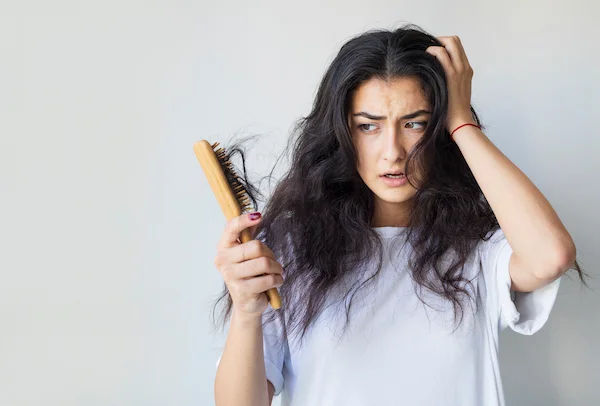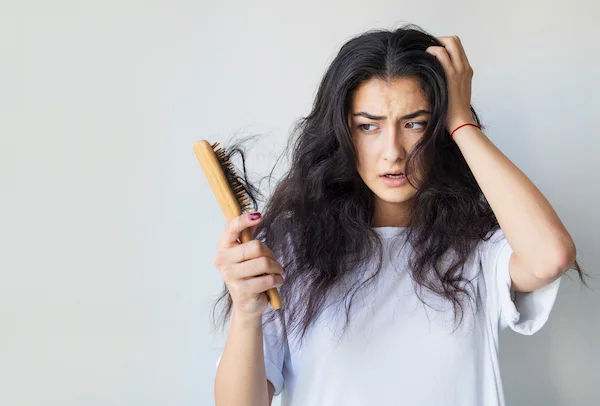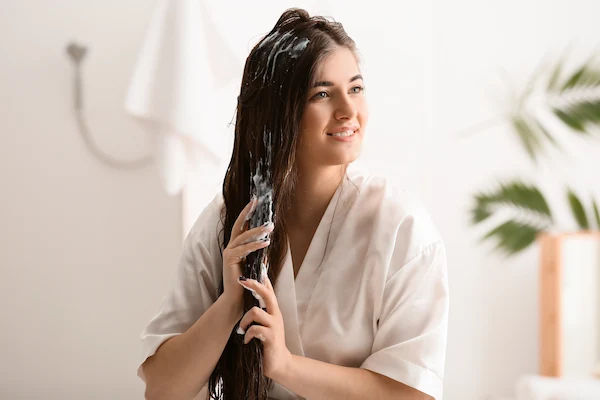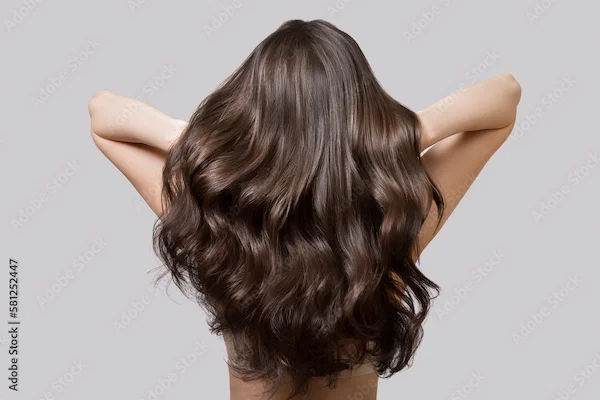Best Home Remedies to Control Frizzy Hair Naturally
Tame frizz the healthy way. Evidence-based frizzy hair remedy ideas, smart hair care habits, and smooth hair tips you can try at home.

Written by Dr. Mohammed Kamran
Reviewed by Dr. D Bhanu Prakash MBBS, AFIH, Advanced certificate in critical care medicine, Fellowship in critical care medicine
Last updated on 13th Nov, 2025

Introduction
Frizz happens to almost everyone—especially in humid weather, after heat styling, or when hair is dry or damaged. The good news: with a few simple changes and gentle at home steps, you can calm flyaways, add shine, and protect your hair over time. In this guide, you’ll find a practical, evidence-informed frizzy hair remedy routine, smart hair care habits, and smooth hair tips that really make a difference.
Why frizz happens (and why it matters)?
Frizz shows up when the outer layer of your hair (the cuticle) lifts, letting moisture move in and out too easily. Hair swells and looks rough or puffy. This is more common when:
• Hair is dry or damaged (from heat tools, coloring, bleach, or harsh brushing)
• Humidity is high
• Hair is naturally curly, coily, or porous
• You overwash or skip conditioner
Frizz doesn’t harm health, but it can signal hair that needs moisture, protection, and gentler handling. A consistent routine can noticeably improve look and feel.
Daily frizzy hair remedy routine for smoother strands
A steady, simple routine beats occasional “miracle” fixes. Try these steps:
Wash less, condition more
• Shampoo your scalp, not your ends: Use a gentle, sulfate free or mild shampoo focused on the scalp. Let the suds run down to cleanse lengths without stripping.
• Condition every wash: Use a rinse out conditioner from mid length to ends. This smooths the cuticle and reduces friction, which helps stop frizz before it starts.
• Choose the right formula: Look for conditioners with ingredients like fatty alcohols (cetyl, stearyl), silicones (dimethicone), or oils that add slip and shine.
Leave in helpers and serums
• Apply a leave in conditioner on damp hair to lock in moisture.
• Finish with a small amount of anti frizz serum or cream. Silicone-based serums can temporarily seal the cuticle and reduce frizz and static.
• Start with a pea sized amount, then adjust. Too much product can weigh hair down.
Dry the right way
• Skip the rough towel drying. Gently squeeze out water and blot with a microfiber towel or soft cotton T shirt to reduce friction.
• Air-dry when possible or diffuse on low heat and low speed.
• Avoid brushing wet hair; instead, detangle with a wide tooth comb while hair is coated with conditioner.
Protect from heat (or use it wisely)
• Keep heat tools on the lowest setting that gets the job done.
• Always use a heat protectant spray or cream before blow drying, curling, or straightening.
• Give hair “off days” from hot tools to limit cuticle damage.
Consult Top Specialists
Weekly at home treatments that work
Pre shampoo oiling (especially with coconut oil)
• Why it helps: Coconut oil can penetrate the hair shaft and has been shown to reduce protein loss when used before washing. Less protein loss = less weakness and breakage that lead to frizz.
• How to do it: Lightly coat dry hair (mid length to ends) with 1–2 teaspoons of coconut oil 30–60 minutes before shampooing. Shampoo and condition as usual. Fine hair may prefer lighter oils (argan, jojoba) or smaller amounts.
• Notes: Avoid heavy oil on the scalp if you’re acne prone or flaky. Patch test if you have sensitive skin.
Deep conditioning mask
• Use a rich mask once a week to replenish moisture and smooth the cuticle.
• Look for masks with conditioning agents (behentrimonium chloride), oils/butters (argan, shea), proteins (hydrolyzed keratin), and humectants (glycerin, aloe).
• Leave on as directed (typically 5–10 minutes) and rinse well.
Clarify or chelate occasionally
• Product buildup and hard water minerals can roughen hair and dull shine.
• Use a clarifying or chelating shampoo no more than every 2–4 weeks, then follow with a deep conditioner. If you have very dry or color treated hair, clarify less often.
Lifestyle and long term hair care for frizz control
Sleep and styling tweaks
• Switch to a satin or silk pillowcase to reduce friction overnight.
• Try protective styles (loose braid, twists, pineapple) to limit tangling.
• Avoid tight hairstyles that stress the hair shaft.
Trim and treat damage
• Regular trims (every 8–12 weeks) prevent split ends from traveling up the hair shaft and making hair look frizzier.
• Be cautious with chemical services (bleach, perms, permanent straightening). Space them out and follow with deep conditioning.
Weather wise strategies
• On humid days, use an anti humidity spray or serum as a final step.
• In dry climates, layer a leave in conditioner under a light oil or serum to reduce moisture loss.
• Keep a small travel size cream or serum for midday touch ups.
Scalp and nutrition basics
• A healthy scalp sets the stage for healthier looking hair. Wash often enough to keep the scalp comfortable and flake free.
• Aim for a balanced diet with adequate protein, iron, zinc, and vitamins. While diet won’t “cure” frizz, poor nutrition can affect overall hair quality.
• Sudden changes in hair texture, increased shedding, or scalp symptoms warrant a check in with a healthcare professional.
Popular DIY remedies: what helps and what to skip?
Apple cider vinegar (ACV) rinses
• Possible benefit: A dilute ACV rinse (1–2 teaspoons in a cup of water) after shampoo may help remove buildup and temporarily smooth the cuticle due to acidity.
• Use sparingly (e.g., every few weeks) and avoid eyes and broken skin. Always condition after to avoid dryness.
• Evidence is limited; many people do well with standard conditioners and occasional clarifying shampoos instead.
Honey or aloe add ins?
• Honey and aloe are humectants and may help hair hold moisture in dry climates.
• They can be sticky or irritating for some. Using products formulated with glycerin or aloe is often easier and more predictable than kitchen recipes.
Egg or mayonnaise masks
• These are traditional remedies but have little scientific support for reducing frizz long term.
• A store bought conditioner or mask is usually safer, cleaner, and more effective.
Keratin/smoothing treatments
• Some salon or at home treatments may contain or release formaldehyde or related chemicals, which can irritate eyes, skin, and lungs and raise safety concerns.
• If you consider a smoothing treatment, ask about ingredients, ventilation, and safety standards, and avoid DIY chemical straighteners. When in doubt, skip it.
A quick checklist of smooth hair tips
• Be gentle: Wash the scalp, condition the lengths every time.
• Lock in moisture: Use a leave in conditioner and a light serum or cream.
• Reduce friction: Microfiber towel, wide tooth comb, satin pillowcase.
• Limit heat: Lower settings, heat protectant, heat free days.
• Treat weekly: Pre wash oil and/or deep conditioning mask.
• Clarify occasionally: Remove buildup, then re hydrate.
• Trim regularly: Keep ends tidy to curb frizz.
When to see a dermatologist?
• Your hair suddenly becomes unusually dry, brittle, or frizzy without changes in routine
• You notice scalp symptoms: itching, burning, scaling, or hair loss
• You’ve had chemical or heat damage and need a recovery plan
• You’re considering chemical smoothing/straightening and want safe optionsConsult Top Specialists
Consult Top Specialists

Dr. Rik Sadhukhan
Ayurveda Practitioner
8 Years • BAMS
Kolkata
Vedhive Ayurveda, Ballygunge, Kolkata

Dr. Pepsy Jose
Panchakarma Practitioner
14 Years • BAMS, MD Ayurveda (Panchakarma)
Bengaluru
AYURRHYTHM HOLISTIC CLINIC AND PANCHAKARMA THERAPY, Bengaluru

Dr. Anjan Das
Ayurveda Practitioner
8 Years • Ayurvedacharya ( B.A.M.S )
Dumdum
Vedhive Ayurveda Clinic, Dumdum

Dr. Shiv Prakash Singh
Ayurveda Practitioner
19 Years • BAMS
Kolkata
Vedhive Ayurveda College Street, Kolkata
Consult Top Specialists

Dr. Rik Sadhukhan
Ayurveda Practitioner
8 Years • BAMS
Kolkata
Vedhive Ayurveda, Ballygunge, Kolkata

Dr. Pepsy Jose
Panchakarma Practitioner
14 Years • BAMS, MD Ayurveda (Panchakarma)
Bengaluru
AYURRHYTHM HOLISTIC CLINIC AND PANCHAKARMA THERAPY, Bengaluru

Dr. Anjan Das
Ayurveda Practitioner
8 Years • Ayurvedacharya ( B.A.M.S )
Dumdum
Vedhive Ayurveda Clinic, Dumdum

Dr. Shiv Prakash Singh
Ayurveda Practitioner
19 Years • BAMS
Kolkata
Vedhive Ayurveda College Street, Kolkata
More articles from Hair Problems
Frequently Asked Questions
1) What is the best natural frizzy hair remedy?
A simple, consistent routine works best: pre shampoo oiling (coconut oil is well studied for reducing protein loss), regular conditioner plus a leave in, and careful drying with a microfiber towel. Add a light serum to seal the cuticle.
2) How often should I wash frizzy hair?
It depends on your scalp and hair type. Many people do well washing 2–3 times per week. Focus shampoo on the scalp and condition every time. If your scalp is oily or you exercise often, you may wash more frequently—just keep conditioning.
3) Do oils make hair greasy?
They can if you use too much or apply them at the roots. Start with a few drops on mid length to end. Fine hair may prefer lighter oils (argan, jojoba) or just a silicone serum. Pre wash oiling is less likely to leave residue.
4) Are sulfate free shampoos better for frizz?
Sulfate free formulas are often milder and less stripping, which can help dry or color treated hair feel smoother. However, the best shampoo is the one your scalp tolerates and that doesn’t leave your hair feeling rough. Always follow with a conditioner.
5) Can diet fix frizz?
A balanced diet supports overall hair health, but external care matters most for frizz control. Keep protein, iron, zinc, and vitamins in range, then focus on gentle cleansing, conditioning, and protection to manage frizz day to day.




